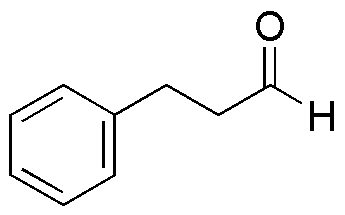Hydrocinnamaldehyde is widely utilized in research focused on:
- Flavor and Fragrance Industry: This compound is commonly used as a flavoring agent in food products and as a fragrance component in cosmetics and personal care items, providing a sweet, floral aroma that enhances sensory appeal.
- Pharmaceuticals: It has potential applications in drug formulation, particularly in the development of anti-inflammatory and antimicrobial agents, due to its bioactive properties that can support therapeutic effects.
- Natural Products Chemistry: Researchers often explore hydrocinnamaldehyde for its role in synthesizing various natural products, which can lead to the discovery of new compounds with beneficial properties.
- Cosmetic Formulations: Its ability to act as a natural preservative makes it valuable in cosmetic products, helping to extend shelf life while maintaining product integrity.
- Aromatherapy: The compound is also used in essential oils and aromatherapy products, where its pleasant scent is believed to promote relaxation and improve mood.
General Information
Properties
Safety and Regulations
Applications
Hydrocinnamaldehyde is widely utilized in research focused on:
- Flavor and Fragrance Industry: This compound is commonly used as a flavoring agent in food products and as a fragrance component in cosmetics and personal care items, providing a sweet, floral aroma that enhances sensory appeal.
- Pharmaceuticals: It has potential applications in drug formulation, particularly in the development of anti-inflammatory and antimicrobial agents, due to its bioactive properties that can support therapeutic effects.
- Natural Products Chemistry: Researchers often explore hydrocinnamaldehyde for its role in synthesizing various natural products, which can lead to the discovery of new compounds with beneficial properties.
- Cosmetic Formulations: Its ability to act as a natural preservative makes it valuable in cosmetic products, helping to extend shelf life while maintaining product integrity.
- Aromatherapy: The compound is also used in essential oils and aromatherapy products, where its pleasant scent is believed to promote relaxation and improve mood.
Documents
Safety Data Sheets (SDS)
The SDS provides comprehensive safety information on handling, storage, and disposal of the product.
Product Specification (PS)
The PS provides a comprehensive breakdown of the product’s properties, including chemical composition, physical state, purity, and storage requirements. It also details acceptable quality ranges and the product's intended applications.
Certificates of Analysis (COA)
Search for Certificates of Analysis (COA) by entering the products Lot Number. Lot and Batch Numbers can be found on a product’s label following the words ‘Lot’ or ‘Batch’.
Número de catálogo
Número de lote/lote
Certificates Of Origin (COO)
This COO confirms the country where the product was manufactured, and also details the materials and components used in it and whether it is derived from natural, synthetic, or other specific sources. This certificate may be required for customs, trade, and regulatory compliance.
Número de catálogo
Número de lote/lote
Safety Data Sheets (SDS)
The SDS provides comprehensive safety information on handling, storage, and disposal of the product.
DownloadProduct Specification (PS)
The PS provides a comprehensive breakdown of the product’s properties, including chemical composition, physical state, purity, and storage requirements. It also details acceptable quality ranges and the product's intended applications.
DownloadCertificates of Analysis (COA)
Search for Certificates of Analysis (COA) by entering the products Lot Number. Lot and Batch Numbers can be found on a product’s label following the words ‘Lot’ or ‘Batch’.
Número de catálogo
Número de lote/lote
Certificates Of Origin (COO)
This COO confirms the country where the product was manufactured, and also details the materials and components used in it and whether it is derived from natural, synthetic, or other specific sources. This certificate may be required for customs, trade, and regulatory compliance.


